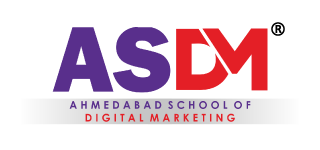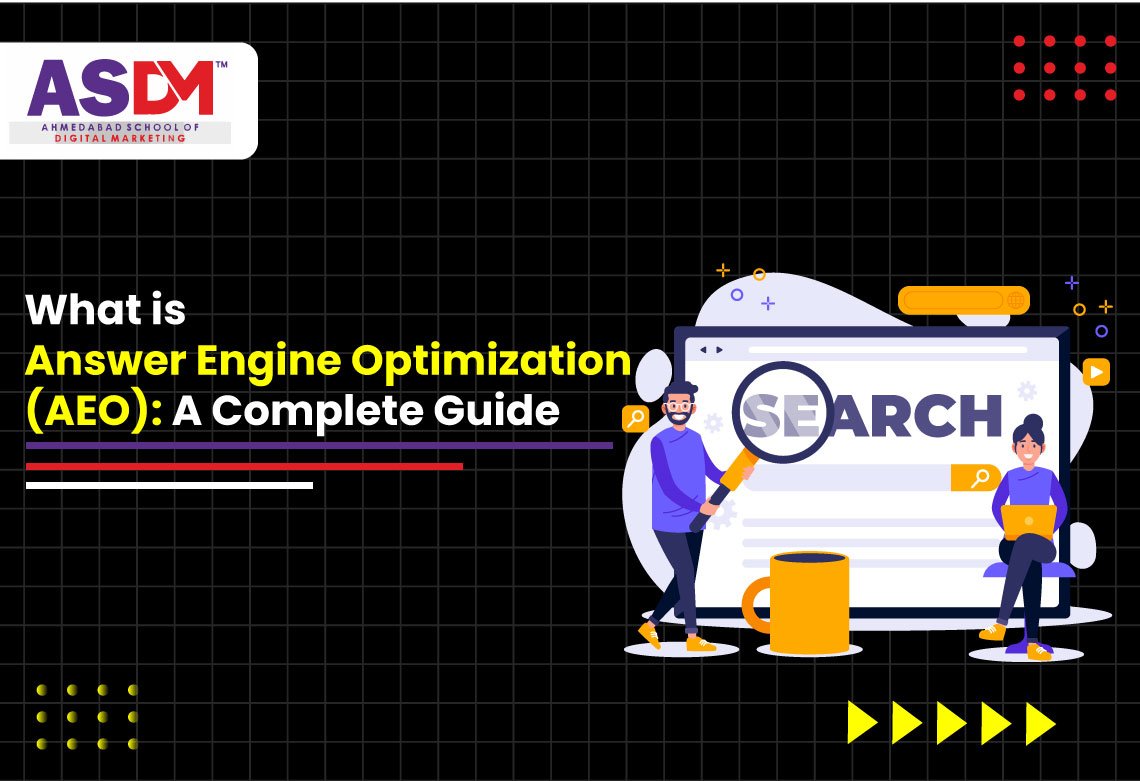Introduction
In today’s digital-first world, search behavior is rapidly changing. With the rise of voice assistants, chatbots, and AI-driven platforms, people no longer just “search” for information—they ask direct questions and expect instant, precise answers. This is where Answer Engine Optimization (AEO) comes into play. AEO goes beyond traditional SEO by focusing on how your content can be structured and optimized to appear as a clear, authoritative, and concise answer in platforms like Google’s featured snippets, voice search, and AI-powered search engines.
Businesses and marketers who understand the importance of AEO can significantly improve their online visibility, build trust, and capture more targeted traffic. Unlike standard SEO practices that mainly optimize for rankings, AEO ensures that your brand becomes the “chosen answer” when users ask questions. Whether it’s through optimizing FAQs, using structured data, or creating content that directly addresses user intent, mastering AEO can set your website apart in the competitive digital landscape.
In this complete guide, we’ll explore what Answer Engine Optimization is, why it matters, and how you can implement it effectively to stay ahead of the curve in this new era of search.
What is Answer Engine Optimization (AEO)?
Answer Engine Optimization (AEO) is the advanced practice of optimizing digital content so that it directly provides clear, concise, and authoritative answers to users’ questions. Unlike traditional search engine optimization (SEO), which focuses mainly on ranking web pages, AEO is about positioning your content to be the best possible answer that search engines, AI assistants, and voice search platforms can deliver instantly.
With the increasing popularity of voice assistants like Alexa, Siri, and Google Assistant, as well as the growth of AI-powered tools, user behavior has shifted. People now prefer asking complete questions rather than typing short keywords. For example, instead of searching for “best digital marketing course,” users ask, “What is the best digital marketing course in India?” Answer engines prioritize content that directly addresses such questions in a simple, structured, and trustworthy way.
AEO leverages strategies such as optimizing FAQs, using schema markup, writing conversational content, and ensuring authoritative credibility. Businesses that adopt AEO not only improve their chances of appearing in featured snippets but also establish themselves as reliable industry experts. Just like enrolling in a Digital Marketing course in Ahmedabad helps learners master the latest tools, AEO ensures your content becomes the preferred response in today’s fast-changing digital search ecosystem.
Difference between SEO and AEO
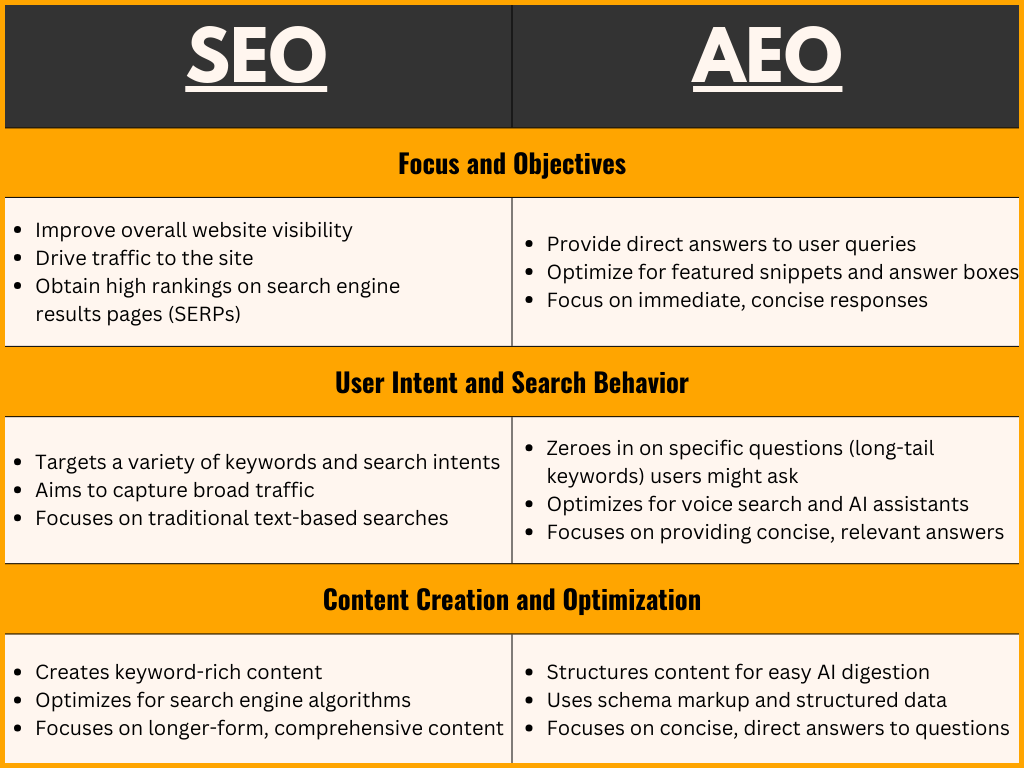
SEO (Search Engine Optimization) and AEO (Answer Engine Optimization) are closely connected but serve slightly different purposes. SEO is primarily about improving your website’s visibility in search engines like Google by targeting keywords, building backlinks, enhancing site speed, and creating optimized content to rank higher on search results pages (SERPs). The goal is to generate organic traffic by ranking above competitors.
On the other hand, AEO focuses less on ranking pages and more on delivering direct answers. Search engines and AI-driven platforms now use Natural Language Processing (NLP) to understand intent. Instead of just matching keywords, they prioritize content that provides a direct, trustworthy, and easy-to-understand response.
For example, SEO may help a page rank for “best smartphones 2025,” but AEO ensures your content gets selected as the featured snippet when a user asks, “Which is the best smartphone in 2025?”
While SEO improves discoverability, AEO enhances answerability. Combining both strategies ensures that your content not only ranks but also gets chosen as the go-to solution, especially in voice searches and AI-driven results.
How Do Answer Engine Optimization Actually Work?
Answer engines are designed to go beyond traditional keyword matching by understanding the intent behind a user’s query. Instead of simply listing web pages, answer engines like Google’s featured snippets, Bing AI, or ChatGPT-powered responses strive to deliver direct, concise, and contextually relevant answers. They rely heavily on Natural Language Processing (NLP), machine learning, and semantic search technology to interpret human-like questions.
When a user types or speaks a query, the answer engine scans billions of data points across the web. It evaluates which content is the most authoritative, trustworthy, and structured to provide a clear response. Unlike search engines that display a list of blue links, answer engines extract and present information in a summarized form—often using featured snippets, “People Also Ask” boxes, or voice-read answers.
Factors like structured data, schema markup, page authority, and content clarity play a huge role in determining whether your content gets chosen. Websites that directly address questions, use conversational language, and back claims with expertise are more likely to be selected. Similarly, a Digital Marketing course in Surat trains learners to apply these strategies effectively, ensuring businesses improve visibility and stay competitive in today’s evolving search landscape.
In short, answer engines are not just delivering search results—they’re acting like digital assistants, providing the best single answer that meets user intent. That’s why mastering Answer Engine Optimization (AEO) is crucial for businesses today.
Role of Structured Data in Answer Engine Optimization (AEO)
Structured data is one of the most powerful tools for Answer Engine Optimization. It provides search engines with extra context about your content, allowing them to understand relationships between information and deliver accurate results. By implementing schema markup (like FAQ schema, product schema, or article schema), businesses can “speak the same language” as search engines.
For example, if you run an e-commerce site, adding structured data to your product pages helps answer engines recognize details such as price, reviews, and availability. This makes it more likely for your content to appear in rich results or featured answers.
Structured data also boosts your chances of being displayed in voice search results. Since voice assistants prefer quick, direct responses, schema helps them identify and pull the most relevant information from your website.
In AEO, structured data acts as the bridge between human queries and machine understanding. It signals authority, improves visibility, and enhances user trust. Without it, even high-quality content may be overlooked by answer engines.
Featured Snippets and People Also Ask (PAA)

Featured snippets and “People Also Ask” (PAA) boxes are prime real estate for AEO. Featured snippets are those highlighted answer boxes that appear above organic search results, providing a direct solution to the user’s query. PAA boxes, on the other hand, display related questions and answers that users commonly search for.
Optimizing for these positions means structuring your content in a way that directly answers questions. Short, clear, and well-organized responses—preferably under 50 words—are often chosen for featured snippets. Adding FAQs to your website, using headers that mirror real user queries, and structuring content with bullet points or numbered lists significantly increases your chances.
PAA optimization requires anticipating related questions and crafting informative, trustworthy answers. For example, if your blog is about AEO, a PAA query might be: “How is AEO different from SEO?” Providing concise and expert-level responses to such questions can help your content get selected.
Together, featured snippets and PAA offer unmatched visibility, brand authority, and higher click-through rates. For AEO success, targeting these elements should be a top priority.
Influence of Conversational Queries
The rise of voice search and AI-powered tools has made conversational queries a central part of Answer Engine Optimization. Instead of typing short, keyword-heavy searches, users now ask natural questions like, “How does AEO help my website rank better?”
Answer engines are built to interpret these natural language queries using NLP (Natural Language Processing). They prioritize content that is written in a conversational, easy-to-understand tone. This is why businesses must shift from keyword stuffing to creating content that sounds like a dialogue with the user.
For example, blog posts with question-based subheadings, FAQs, and simple explanations resonate better with answer engines. Conversational queries also align closely with voice search, where answers need to be quick, direct, and human-like.
Optimizing for conversational queries means anticipating the exact phrases people use, addressing them clearly, and providing trustworthy insights. By doing so, businesses not only capture voice search results but also build stronger credibility with audiences who expect instant and personalized answers.
Key Benefits of Answer Engine Optimization (AEO) for Businesses
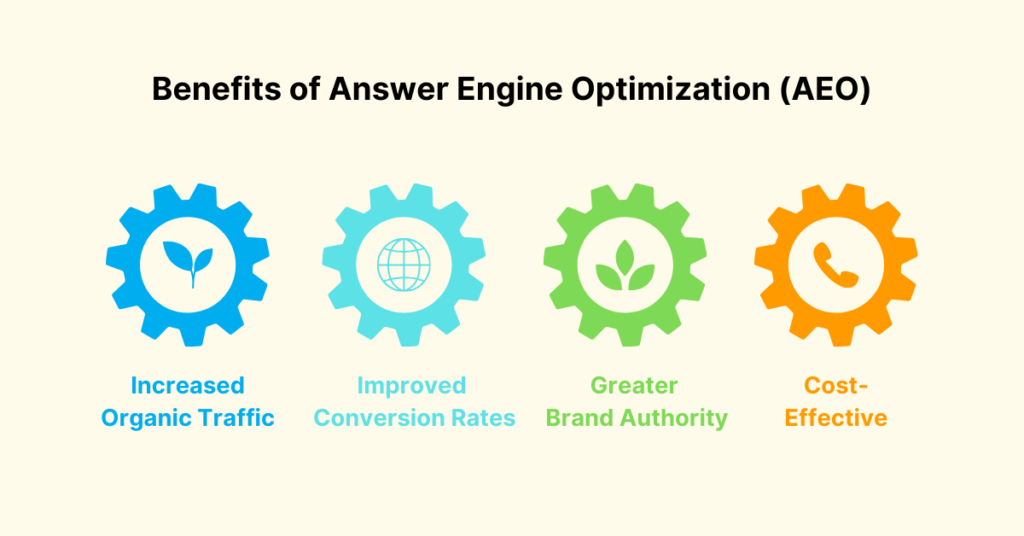
Answer Engine Optimization (AEO) is not just a buzzword—it’s a powerful strategy that helps businesses thrive in today’s evolving search landscape. By focusing on providing direct and accurate answers to user queries, AEO ensures that your brand is more visible, trustworthy, and accessible across multiple platforms, including search engines, voice assistants, and AI-driven tools.
For businesses, the advantages of AEO go far beyond traditional SEO. It allows companies to position themselves as industry experts by consistently offering relevant and reliable answers. This builds long-term credibility with customers while also attracting more qualified traffic. Moreover, AEO helps brands stand out in competitive markets by increasing their chances of being featured in Google’s snippets, “People Also Ask” sections, and voice search results.
In a world where users demand quick and precise responses, businesses that invest in AEO are more likely to capture customer attention, improve engagement, and drive conversions. It’s not just about ranking high—it’s about becoming the chosen source of truth when users ask questions.
Higher Visibility in Search Results
One of the biggest benefits of AEO is enhanced visibility. Traditional SEO strategies help improve rankings, but AEO takes it further by making your content the featured answer. When your business secures a position in featured snippets, People Also Ask sections, or voice search responses, your visibility skyrockets.
This higher visibility doesn’t just boost traffic; it also places your brand in front of users at the exact moment they are seeking information. Unlike paid ads, which disappear when budgets run out, AEO-driven placements provide long-term value. By structuring your content around user intent, FAQs, and schema markup, your website has a greater chance of being recognized as the best answer.
Ultimately, improved visibility through AEO builds awareness, creates stronger digital presence, and helps businesses outshine competitors.
Building Authority and Trust
Trust is the foundation of digital success, and AEO plays a direct role in establishing it. When your business consistently provides accurate, reliable, and expert-level answers, search engines view your content as authoritative. This recognition translates into higher placements in answer boxes, knowledge panels, and voice search results.
For users, being chosen as the “go-to answer” builds confidence in your brand. Customers are more likely to engage with and rely on a business that consistently delivers value. Over time, this authority fosters stronger relationships, customer loyalty, and even higher conversion rates.
Backed by google EEAT principles—Expertise, Experience, Authoritativeness, and Trustworthiness—AEO enables brands to position themselves as thought leaders. Instead of blending into the crowded search results, your business stands out as the reliable source that both people and algorithms trust.
Driving Qualified Organic Traffic
AEO isn’t just about visibility—it’s about attracting the right audience. By directly addressing user queries with precise answers, businesses naturally draw in people who are actively seeking solutions. This leads to highly qualified organic traffic that is more likely to convert into leads or sales.
For instance, if a potential customer asks, “Which is the best CRM for small businesses?” and your content provides the direct, featured answer, that user is already primed with intent. This level of targeting reduces bounce rates and increases engagement.
Moreover, qualified traffic driven through AEO has long-term value. Unlike paid campaigns that require constant investment, optimized answers continue to bring in consistent visitors. By aligning your content with user intent, conversational queries, and structured data, you ensure that your brand consistently attracts and nurtures the right audience.
Strategies to Optimize for Answer Engines Optimization
Use Structured Data Markup
Structured data markup is essential for making your content understandable to answer engines. By implementing schema (like FAQ, How-To, or Product schema), you provide search engines with context that goes beyond plain text. This markup helps highlight important details—such as prices, ratings, or step-by-step instructions—making your content more likely to be pulled for featured snippets, knowledge panels, or voice search results. Structured data essentially “talks” to search engines, signaling that your content is authoritative and answer-ready.
Create Concise and Direct Content
Answer engines prioritize clarity and brevity. Instead of long-winded explanations, focus on delivering short, direct, and precise answers at the start of your content. A good practice is to provide a 40–60 word definition or solution upfront, then expand with supporting details. This makes it easier for Google and voice assistants to extract your content for quick responses. Clarity ensures that both algorithms and users find immediate value.
Optimize for Voice Search Queries
With the growth of smart speakers and voice assistants, voice search has become a critical part of AEO. People phrase queries conversationally, like “What is AEO, and why does it matter?” Optimizing for these natural language queries involves writing in a conversational tone, using question-based headings, and ensuring answers are simple enough to be spoken aloud. Voice search optimization boosts visibility and positions your brand as user-friendly.
Focus on FAQs and Long-Tail Keywords
FAQs and long-tail keywords are highly effective in capturing answer engine results. Users often phrase searches as questions, and FAQs allow you to pre-emptively answer them. Long-tail keywords, such as “best digital marketing course for beginners in India”, have lower competition and higher intent, making them ideal for AEO. Structuring your content around FAQs ensures you cover multiple user intents while signaling relevance to search engines.
Build Topical Authority with EEAT
Google’s EEAT (Expertise, Experience, Authoritativeness, and Trustworthiness) plays a vital role in AEO. To build topical authority, consistently publish high-quality, research-backed content in your niche. Showcase author credentials, cite reputable sources, and share real-world case studies. The more your content reflects expertise and reliability, the more likely answer engines are to select it. Over time, strong EEAT not only boosts AEO but also establishes your brand as a trusted industry leader.
Role of Influencers in Answer Engine Optimization (AEO)
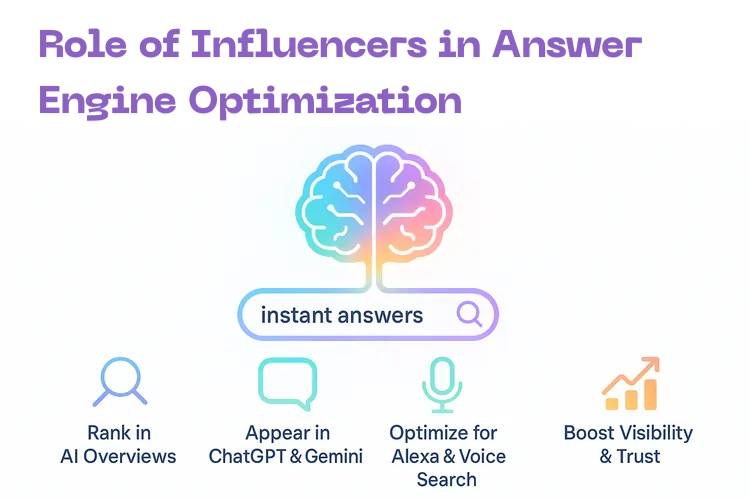
In the era of Answer Engine Optimization (AEO), influencers play a surprisingly powerful role in shaping how content is discovered and trusted. Answer engines thrive on authority, authenticity, and relevance—qualities that established influencers often embody. When influencers create content that directly answers questions within their niche, it has a higher chance of being picked up by AI-driven search results, voice assistants, and featured snippets.
Unlike traditional SEO that relies heavily on backlinks and keywords, AEO is more focused on context and credibility. Influencers, who already command large, engaged audiences, provide strong signals of expertise and trustworthiness. For brands, collaborating with influencers not only improves visibility but also increases the chances of appearing as a chosen answer in search queries.
Whether it’s a tech influencer explaining product comparisons, a health expert answering wellness-related questions, or a marketing professional breaking down strategies, influencer-driven content aligns perfectly with user intent. This mix of authority and relatability enhances both AEO success and long-term brand trust.
How Influencer Content Ranks in AI-Driven Results
AI-driven search engines and answer engines prioritize content that reflects authority, relevance, and clarity. Influencer content often checks all these boxes because it’s created by individuals with proven expertise in their fields. Search algorithms view influencers as credible sources since their content is widely shared, referenced, and interacted with by loyal audiences.
For example, when a fitness influencer explains “What are the best post-workout recovery foods?”, their content is more likely to appear in featured snippets or voice answers compared to a generic website. This happens because AI models recognize social signals, backlinks, and engagement as indicators of authority.
Additionally, influencers tend to create conversational, easy-to-understand content—something AI engines prioritize when answering voice queries. Brands leveraging influencer partnerships gain a competitive edge by combining influencer credibility with optimized content formats suitable for AEO.
Authenticity and Trust Signals
One of the most critical aspects of AEO is trust. Search engines and AI models are becoming increasingly sophisticated at detecting authenticity, and influencer content naturally provides strong trust signals. Unlike generic brand messaging, influencer content feels personal, relatable, and grounded in real experiences.
When influencers share honest reviews, tutorials, or expert tips, it not only resonates with audiences but also signals credibility to algorithms. Engagement metrics like comments, shares, and mentions further amplify these trust signals, increasing the chances of content being selected as a reliable answer.
For businesses, this means partnering with influencers who have genuine authority in their niche is far more impactful than chasing vanity metrics. Authentic voices backed by expertise strengthen EEAT (Expertise, Experience, Authoritativeness, Trustworthiness), positioning influencer content as a top contender in AI-driven results.
The Future of Answer Engine Optimization (AEO)
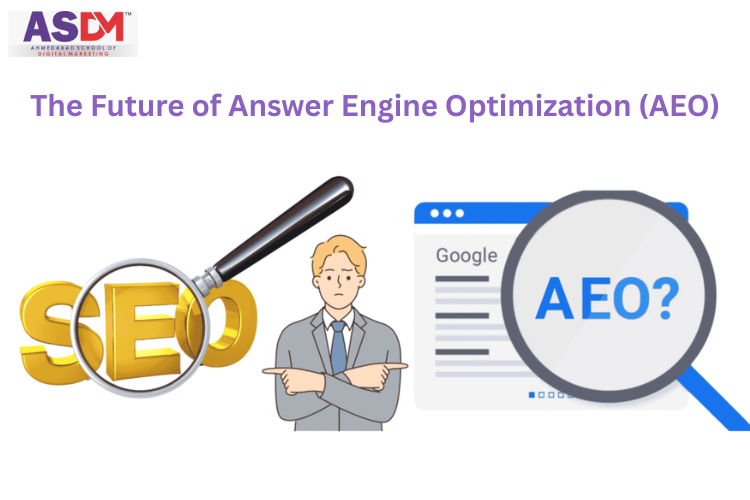
The future of Answer Engine Optimization (AEO) is closely tied to the rapid evolution of artificial intelligence, natural language processing, and voice-enabled technologies. As user behavior shifts from typing short keywords to asking conversational questions, businesses must adapt their digital strategies to ensure visibility across AI-driven platforms.
AEO is expected to become the backbone of modern search marketing because people increasingly seek direct, accurate, and trustworthy answers. Whether through featured snippets, voice search, or AI-powered assistants, the demand for clear, concise, and credible responses will only grow. Brands that focus on structured data, topical authority, and user trust will thrive in this environment.
In the coming years, AEO will move beyond Google and traditional search engines, extending into AI chatbots, smart devices, and multi-platform ecosystems. Companies that embrace this shift early will gain a significant competitive edge, as being “the chosen answer” will matter more than ranking on page one.
Impact of ChatGPT, Gemini, and Other AI Tools
AI tools like ChatGPT, Google Gemini, and Claude are transforming how people access information. Instead of browsing through multiple websites, users now receive instant, conversational answers directly from AI systems. This shift means businesses must optimize content not only for search engines but also for google AI models that curate responses.
ChatGPT and Gemini analyze massive amounts of data to provide authoritative answers. Content that is structured, well-cited, and written in a conversational tone has a higher chance of being surfaced by these tools. Moreover, AI models rely heavily on trust signals, meaning brands with strong EEAT and credibility are more likely to be featured.
For businesses, the takeaway is clear: creating high-quality, answer-focused content is no longer optional—it’s essential for staying relevant in an AI-driven search ecosystem.
Predictions for the Next 5 Years
Over the next five years, AEO will become a standard part of every digital marketing strategy. Search engines and AI platforms will increasingly prioritize direct answers, pushing businesses to adapt content strategies accordingly. Voice search usage will continue to grow, with smart assistants becoming central to how users access information.
We can also expect AI models like ChatGPT and google Gemini to evolve into personalized answer engines, tailoring responses based on user preferences and past behavior. This means businesses must focus not just on visibility but also on personalization and relevance.
Additionally, EEAT will play an even bigger role. Brands that demonstrate real expertise, authenticity, and trust will dominate answer boxes, AI summaries, and voice search results. Companies that invest in structured data, FAQs, and authority-building today will be best positioned for tomorrow’s competitive digital landscape.
Conclusion
Answer Engine Optimization (AEO) is no longer just a trend—it is the future of digital visibility. As search behavior continues to evolve with the rise of AI-driven tools like ChatGPT, Google Gemini, and voice assistants, businesses must move beyond traditional SEO and embrace strategies that make their content the preferred answer.
The shift from keyword-based searches to conversational queries means brands need to focus on clarity, trust, and authority. Using structured data, optimizing for voice search, building topical expertise, and delivering concise, direct answers will be the key to success. AEO is not only about ranking but also about becoming the trusted voice that answer engines recognize and users rely on.
For businesses, this presents a powerful opportunity. By aligning with EEAT principles—Expertise, Experience, Authoritativeness, and Trustworthiness—you can position your brand as the go-to source of knowledge in your niche. Those who adapt early will capture higher visibility, build stronger authority, and attract qualified organic traffic in an increasingly competitive digital landscape. To dive deeper into this concept, you can also read or understand What is Generative Engine Optimization (GEO)? for better insights.
FAQS
What Is answer engine optimization?
If you’re wondering what is Answer Engine Optimization (AEO)?, it’s the process of optimizing content for direct answers on search engines. To do AEO effectively, you must understand how do answer engines actually work by analyzing structured data and intent-based content. The key benefits of AEO include higher visibility, better click-throughs, and credibility. Moreover, the role of influencers in AEO has grown, as they help amplify trust and authority, making your content more discoverable.
How to use Answer Engine Optimization (AEO)?
To use AEO, first ask yourself what is Answer Engine Optimization (AEO)? It’s about creating structured, concise, and clear content that provides direct answers. By knowing how do answer engines actually work, you can design pages optimized with schema markup and FAQs. The key benefits of AEO include voice search dominance and improved user trust. Also, the role of influencers in AEO cannot be ignored, as influencers boost credibility and help your answers rank higher.
How do I do an Answer Engine Optimization (AEO) for my website?
To implement AEO for your site, start by asking what is Answer Engine Optimization (AEO)? Then optimize pages with schema, featured snippets, and conversational content. Once you understand how do answer engines actually work, you can structure Q&A-based blogs. The key benefits of AEO include higher rankings and more targeted traffic. Don’t forget the role of influencers in AEO, as their authority-driven mentions improve the trustworthiness of your answers across digital platforms.
What is AEO in AI?
Many wonder, what is Answer Engine Optimization (AEO)? In the AI era, AEO aligns content with intelligent answer engines like ChatGPT and Google’s SGE. To apply it, know how do answer engines actually work with AI-powered intent recognition. The key benefits of AEO include visibility in AI-driven responses and voice searches. Additionally, the role of influencers in AEO has increased, as influencers’ credibility strengthens how AI systems rank and display trusted content answers.
Why is Answer Engine Optimization (AEO) important?
The importance starts with understanding what is Answer Engine Optimization (AEO)? It ensures your brand is visible when users search for quick answers. Once you know how do answer engines actually work, you can build structured, intent-focused content. The key benefits of AEO are stronger online authority, higher organic traffic, and dominance in voice search. Finally, the role of influencers in AEO is vital, as they validate trust signals that answer engines prioritize in rankings.
What are the best tools for answer engine optimization?
When asking about tools, start with what is Answer Engine Optimization (AEO)? Tools like SEMrush, Ahrefs, and schema generators help optimize content. Knowing how do answer engines actually work allows you to use these tools effectively. The key benefits of AEO with tools include data-driven content, higher SERP rankings, and enhanced visibility. Importantly, the role of influencers in AEO ties in here, as influencer insights combined with tools maximize reach and trustworthiness online.
